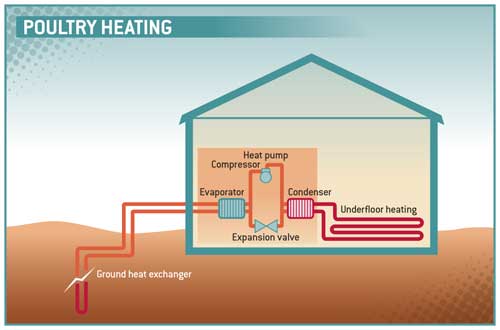Heat pumps offer low energy heating for poultry

Under floor heating offers many cost savings to poultry businesses, but to get the full benefit, it needs to be coupled up with a sophisticated control system and a renewable source of heat, according to one expert
The biggest difference between under floor heating and traditional gas heating is that it uses radiant heating rather than convection, says Damian Baker of Norwich-based RenEnergy. “This means you don’t get hit by waves of heat.”
It also delivers heat where you need it. People tend to feel most comfortable with a temperature profile with warmer air at their feet and cooler air around the head. It is similar with birds, but traditional convection heaters give you the opposite.
Furthermore, with gas burners you get high rates of convection, which leads to air currents moving bugs and mites around the house. Another advantage of under floor heating is that litter is dryer, which is better for the health of the birds’ feet.
In contrast with domestic and industrial uses, under floor systems are still in their infancy in the farming sector. And Mr Baker believes some producers are missing out on some of the potential cost savings because of poor control over water flow rates in the piping and temperature.
“Existing systems that I have visited use a fixed flow rate, which for poultry means systems are operating at a higher water temperature than that is necessary.
“With modern systems, you can control the air temperature and set a minimum/maximum for the floor, therefore, giving you the right balance of heat. Fuel savings are further enhanced with the weather compensated flow temperature function, reducing the heat input on warmer days. It automatically adjusts the flow temperature using temperature probes outside the shed and buried in the floor.
 “By having this extra control, you can save an extra 10-15% in running costs of under floor heating systems,” he says.
“By having this extra control, you can save an extra 10-15% in running costs of under floor heating systems,” he says.
Many associate under floor heating systems with new build poultry units, but as Mr Baker points out, it can also be retrospectively fitted in certain types of existing building where there is no problem in raising the floor level.
The next main consideration is how to power it and this can be achieved using conventional oil or gas boilers, or by using renewable energy such as biomass boilers, air source heat pumps or ground source heat pumps.
Ground source heat pumps are an efficient way of providing heat and they can run an under floor poultry heating system. The most common system consists of piping laid under the soil filled with water plus glycol which extracts the low grade heat from the ground. At a depth of 2m, the soil temperature is fairly constant at about 9-13 degrees all year round.
The mixture is pumped through the system and on the demonstration system visited by Poultry World, the water/glycol mixture was entered the unit at 17 degrees. It then went through a heat exchanger containing a refrigerant gas, which is good at gaining and losing heat when compressed.
“It’s a bit like when you pump a tyre on a bike and the pump gets hot,” says Mr Baker.
This goes through another heat exchanger to recover heat from the gas into water, which then circulates through the under floor pipes. The result is water leaving the unit at up to 60 degrees.
Mr Baker says that in his experience, ground source heat pumps are capable of heating chicken sheds to 30 degrees inside even when the outside temperature is minus five degrees down the first 1m of ground.
For sites with insufficient area for laying pipes, heat exchange technology can also work using water from river, the sea or lakes, by using the low grade heat in water.
The cost of installing an under floor heating system, including controls, pumps and piping equates to about £2/sq ft and this can be heated with any boiler. He admits that ground source technology has a significant capital cost of about £2.50/sq ft, but over several years it will pay for itself.
“For every 1kw of energy you put into a ground source pump, you get 4.5kw out. Overall when comparing the system with gas radiant heating, combining under floor heating with renewable energy can bring a 40-50% saving in heating costs.”
